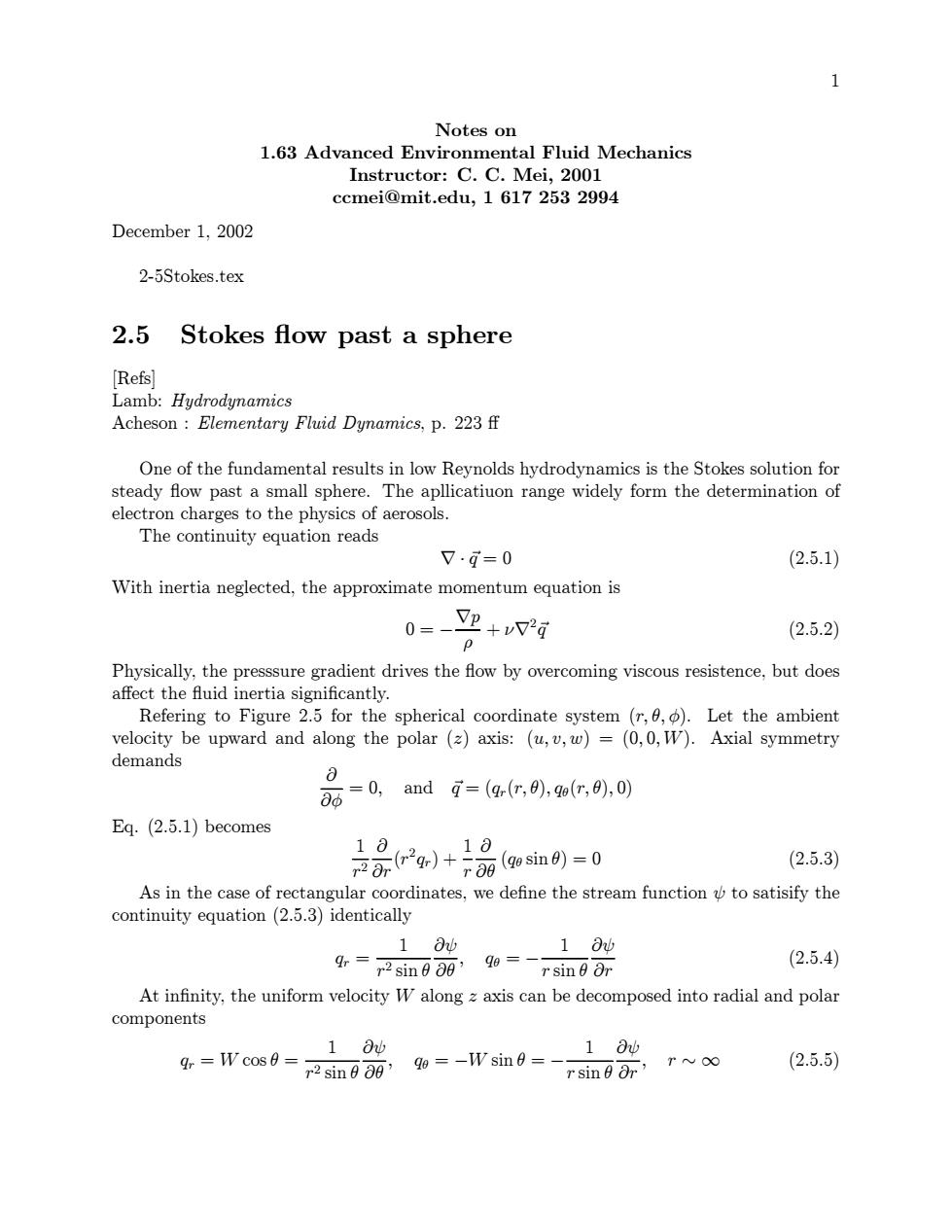正在加载图片...

1 Notes on 1.63 Advanced Environmental Fluid Mechanics Instructor:C.C.Mei,2001 ccmei@mit.edu,1 617 253 2994 December 1,2002 2-5Stokes.tex 2.5 Stokes flow past a sphere [Refs] Lamb:Hydrodynamics Acheson Elementary Fluid Dynamics,p.223 ff One of the fundamental results in low Reynolds hydrodynamics is the Stokes solution for steady flow past a small sphere.The apllicatiuon range widely form the determination of electron charges to the physics of aerosols. The continuity equation reads 7.q=0 (2.5.1) With inertia neglected,the approximate momentum equation is 0=-2+v2g (2.5.2) Physically,the presssure gradient drives the flow by overcoming viscous resistence,but does affect the fluid inertia significantly. Refering to Figure 2.5 for the spherical coordinate system(r,0,o).Let the ambient velocity be upward and along the polar (z)axis:(u,v,w)=(0,0,W).Axial symmetry demands 86=0,andg=(g(,9),9o(,9),0) Eq.(2.5.1)becomes 182gr)+ 18 r2Or ra0 (gosine)=0 (2.5.3) As in the case of rectangular coordinates,we define the stream function to satisify the continuity equation (2.5.3)identically 10b 1∂b 4r=r2sin0∂9' 90= (2.5.4) rsin0 Or At infinity,the uniform velocity W along z axis can be decomposed into radial and polar components 10b 18b 4-Wcos0=2sin 00 e--W sin0-- rsin98r,r~∞ (2.5.5)1 Notes on 1.63 Advanced Environmental Fluid Mechanics Instructor: C. C. Mei, 2001 ccmei@mit.edu, 1 617 253 2994 December 1, 2002 2-5Stokes.tex 2.5 Stokes flow past a sphere [Refs] Lamb: Hydrodynamics Acheson : Elementary Fluid Dynamics, p. 223 ff One of the fundamental results in low Reynolds hydrodynamics is the Stokes solution for steady flow past a small sphere. The apllicatiuon range widely form the determination of electron charges to the physics of aerosols. The continuity equation reads ∇ · ~q = 0 (2.5.1) With inertia neglected, the approximate momentum equation is 0 = −∇p ρ + ν∇2 ~q (2.5.2) Physically, the presssure gradient drives the flow by overcoming viscous resistence, but does affect the fluid inertia significantly. Refering to Figure 2.5 for the spherical coordinate system (r, θ, φ). Let the ambient velocity be upward and along the polar (z) axis: (u, v, w) = (0, 0, W). Axial symmetry demands ∂ ∂φ = 0, and ~q = (qr(r, θ), qθ(r, θ), 0) Eq. (2.5.1) becomes 1 r2 ∂ ∂r (r2 qr) + 1 r ∂ ∂θ (qθ sin θ) = 0 (2.5.3) As in the case of rectangular coordinates, we define the stream function ψ to satisify the continuity equation (2.5.3) identically qr = 1 r2 sin θ ∂ψ ∂θ , qθ = − 1 r sin θ ∂ψ ∂r (2.5.4) At infinity, the uniform velocity W along z axis can be decomposed into radial and polar components qr = W cos θ = 1 r2 sin θ ∂ψ ∂θ , qθ = −W sin θ = − 1 r sin θ ∂ψ ∂r , r ∼ ∞ (2.5.5)